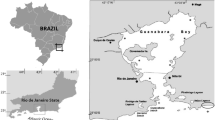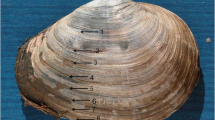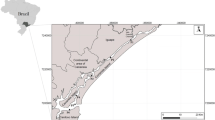Abstract
A multibiomarker approach was developed on juvenile Atlantic tomcod (Microgadus tomcod) to evaluate the pertinence of this approach for low-cost screening assessment of the environmental quality of various coastal sites within estuaries. Several biometric indices and biomarkers (ethoxyresorufin-O-deethylase (EROD) activity, metallothionein concentration, and immune responses) were investigated on immature and maturing tomcods (≤31 months) collected in four environmentally contrasted sites in the St. Lawrence Estuary (SLE). Simultaneous examination of various age classes provides the opportunity to detect short-term responses in sensitive young-of-the-year fish (e.g., EROD induction) and longer-time effects associated with chronic exposure and bioaccumulation (e.g., metallothionein induction). Principal component analysis was helpful to discriminate between responses possibly related to contaminant exposure (EROD, metallothionein) and responses that could be affected by upstream–downstream gradient (immune response, biometric indices). Measurement of a battery of biomarkers in young tomcods at several sites along the shore of the SLE is a low-cost screening investigation useful to identify hot spots requiring further investigation with chemical analysis and additional reference sites.







Similar content being viewed by others
References
Aarab N, Champeau O, Mora P, Daubeze M, Garrigues P, Narbonne JF (2004) Scoring approach based on fish biomarkers applied to French river monitoring. Biomarkers 9(3):258–270. doi:10.1080/13547500400015626
Arkoosh MR, Casillas E, Clemons E, Kagley AN, Olson R, Reno P, Stein JE (1998) Effect of Pollution on Fish Diseases: Potential Impacts on Salmonid Populations. J Aquat Anim Health 10(2):182–190. doi:10.1577/1548-8667(1998)010<0182:eopofd>2.0.co;2
Arkoosh M, Clemons E, Huffman P, Kagley A, Casillas E, Adams N, Sanborn H, Collier T, Stein J (2001) Increased susceptibility of juvenile chinook salmon to vibriosis after exposure to chlorinated and aromatic compounds found in contaminated urban estuaries. J Aquat Anim Health 13:257–268
Bernier J, Brousseau P, Krzystyniak K, Tryphonas H, Fournier M (1995) Immunotoxicity of heavy metals in relation to Great Lakes. Environ Health Perspect 103(Suppl 9)
Bols NC, Brubacher JL, Ganassin RC, Lee LEJ (2001) Ecotoxicology and innate immunity in fish. Dev Comp Immunol 25(8–9):853–873
Brousseau P, Payette Y, Tryphonas H, Blakley B, Boermans H, Flipo D, Fournier M (1999) Manual of immunological methods. Handbooks in Pharmacology and Toxicolog. CRC Press, Boston
Burnett KG, Bain LJ, Baldwin WS, Callard GV, Cohen S, Di Giulio RT, Evans DH, Gómez-Chiarri M, Hahn ME, Hoover CA, Karchner SI, Katoh F, MacLatchy DL, Marshall WS, Meyer JN, Nacci DE, Oleksiak MF, Rees BB, Singer TD, Stegeman JJ, Towle DW, Van Veld PA, Vogelbein WK, Whitehead A, Winn RN, Crawford DL (2007) Fundulus as the premier teleost model in environmental biology: Opportunities for new insights using genomics. Comp Biochem Physiol D Genom Proteomics 2(4):257–286. doi:10.1016/j.cbd.2007.09.001
Carlson EA, Roy NK, Wirgin II (2009) Microarray analysis of polychlorinated biphenyl mixture–induced changes in gene expression among Atlantic tomcod populations displaying differential sensitivity to halogenated aromatic hydrocarbons. Environ Toxicol Chem 28(4):759–771. doi:10.1897/08-195r.1
Chilmonczyk S, Monge D (1999) Flow cytometry as a tool for assessment of the fish cellular immune response to pathogens. Fish Shellfish Immunol 9(4):319–333. doi:10.1006/fsim.1998.0188
Chouinard GA, Swain DP (2002) Depth-dependent variation in condition and length-at-age of Atlantic cod (Gadus morhua) in the southern Gulf of St. Lawrence. Can J Fish Aquat Sci 59(9):1451
Cormier SM, Racine RN, Smith CE, Dey WP, Peck TH (1989) Hepatocellular carcinoma and fatty infiltration in the Atlantic tomcod, Microgadus tomcod (Walbaum). J Fish Dis 12(2):105–116
Couillard CM (2009) Utilisation des poissons pour évaluer les effets biologiques des contaminants dans l’estuaire du Saint-Laurent et le fjord du Saguenay/use of fish to assess biological effects of contaminants in the St. Lawrence Estuary and Saguenay Fjord. Revue des sciences de l’eau/J Water Sci n°22 (2):291–314 (in French)
Couillard CM, Williams PJ, Courtenay SC, Rawn GP (1999) Histopathological evaluation of Atlantic tomcod (Microgadus tomcod) collected at estuarine sites receiving pulp and paper mill effluent. Aquat Toxicol 44(4):263–278. doi:10.1016/s0166-445x(98)00085-x
Couillard CM, Wirgin II, Lebeuf M, Légaré B (2004) Reduction of cytochrome P4501A with age in Atlantic tomcod from the St. Lawrence Estuary, Canada: relationship with emaciation and possible effect of contamination. Aquat Toxicol 68(3):233–247. doi:10.1016/j.aquatox.2004.03.012
Couillard CM, Lebeuf M, Ikonomou MG, Poirier GG, Cretney WJ (2005) Low hepatic ethoxyresorufin-o-deethylase activity correlates with high organochlorine concentrations in Atlantic tomcod from the Canadian east coast. Environ Toxicol Chem 24(10):2459–2469. doi:10.1897/05-048r.1
Dutil J-D, Lambert Y, Chabot D (2003) Winter and spring changes in condition factor and energy reserves of wild cod compared with changes observed during food-deprivation in the laboratory. ICES J Mar Sci J Cons 60(4):780–786. doi:10.1016/s1054-3139(03)00024-9
Evrard E, Devaux A, Bony S, Cachot J, Charrier G, Quiniou L, Laroche J (2012) Responses of juvenile European flounder (Platichthys flesus) to multistress in the Vilaine estuary, during a 6-month survey. Environ Sci Pollut Res 1–14 doi:10.1007/s11356-012-1138-z
Fang JKH, Au DWT, Chan AKY, So LKY, Liu WH, Mok HOL, Yu WY, Wu RSS, Shin PKS (2010) Ethoxyresorufin-O-deethylase enzyme activities and accumulation of secondary/tertiary lysosomes in rabbitfish Siganus oramin as biomarkers for xenobiotic exposures. Sci Total Environ 408(20):4833–4840. doi:10.1016/j.scitotenv.2010.06.003
Fasulo S, Marino S, Mauceri A, Maisano M, Giannetto A, D’Agata A, Parrino V, Minutoli R, De Domenico E (2010) A multibiomarker approach in Coris julis living in a natural environment. Ecotox Environ Safe 73(7):1565–1573. doi:10.1016/j.ecoenv.2010.01.008
Fernandez MP, Ikonomou MG, Courtenay SC, Wirgin II (2004) Spatial variation in hepatic levels and patterns of PCBs and PCDD/Fs among young-of-the-year and adult Atlantic tomcod (Microgadus tomcod) in the Hudson River Estuary. Environ Sci Technol 38(4):976–983. doi:10.1021/es034177f
Finkelstein ME, Grasman KA, Croll DA, Tershy BR, Keitt BS, Jarman WM, Smith DR (2007) Contaminant-associated alteration of immune function in black-footed albatross (Phoebastria nigripes), a North Pacific predator. Environ Toxicol Chem 26(9):1896–1903. doi:10.1897/06-505r.1
Flammarion P, Devaux A, Nehls S, Migeon B, Noury P, Garric J (2002) Multibiomarker responses in fish from the Moselle River (France). Ecotox Environ Safe 51(2):145–153. doi:10.1006/eesa.2001.2134
Fortin R, Léveillé M, Laramée P, Mailhot Y (1990) Reproduction and year-class strength of the Atlantic tomcod (Microgadus tomcod) in the Sainte-Anne River, at La Pérade, Québec. Can J Zool 68(7):1350–1359
Fournier M, Cyr D, Blakley B, Boermans H, Brousseau P (2000) Phagocytosis as a biomarker of immunotoxicity in wildlife species exposed to environmental xenobiotics. Am Zool 40(3):412
Gagnon M (1997) Bilan régional Gaspésie-Sud—Baie des Chaleurs : zone d’intervention prioritaire 20B. Centre Saint-Laurent (in French)
Gagnon M (1998) Regional assessment: south shore of the St. Lawrence upper estuary. Priority intervention zones 15, 16 and 17. Environment Canada—Quebec Region, Environmental Conservation, St. Lawrence Centre
GENIVAR (2012) Aménagement d’infrastructures portuaires au Port de Sept-Îles, Construction d’un quai multi-usagers à Pointe-Noire—Examen environnemental préalable. (in French)
George SG, Olsson PE (1994) Metallothioneins as indicators of trace metal pollution. In: Kramer KJM (ed) Biomonitoring of coastal waters and estuaries. CRC Press, Boca Raton, pp 151–178
Guimaraes L, Gravato C, Santos J, Monteiro LS, Guilhermino L (2009) Yellow eel (Anguilla anguilla) development in NW Portuguese estuaries with different contamination levels. Ecotoxicology 18(4):385–402. doi:10.1007/s10646-008-0294-x
Gungordu A, Ozmen M (2011) Assessment of seasonal and sex-related variability of biomarkers in carp (Cyprinus carpio L.) from Karakaya Dam Lake, Turkey. Environ Toxicol Pharmacol 31(3):347–356. doi:10.1016/j.etap.2010.12.004
Humphrey CA, King SC, Klumpp DW (2007) A multibiomarker approach in barramundi (Lates calcarifer) to measure exposure to contaminants in estuaries of tropical North Queensland. Mar Pollut Bull 54(10):1569–1581. doi:10.1016/j.marpolbul.2007.06.004
Johnson LL, Stehr CM, Olson OP, Myers MS, Pierce SM, Wigren CA, McCain BB, Varanasi U (1993) Chemical contaminants and hepatic lesions in winter flounder (Pleuronectes americanus) from the northeast coast of the United States. Environ Sci Technol 27(13):2759–2771
Kerambrun E, Henry F, Marechal A, Sanchez W, Minier C, Filipuci I, Amara R (2012) A multibiomarker approach in juvenile turbot, Scophthalmus maximus, exposed to contaminated sediments. Ecotox Environ Safe 80:45–53. doi:10.1016/j.ecoenv.2012.02.010
Khan RA, Payne JF (2002) Some factors influencing EROD activity in winter flounder (Pleuronectes americanus) exposed to effluent from a pulp and paper mill. Chemosphere 46(2):235–239. doi:10.1016/s0045-6535(01)00125-4
Kirby MF, Matthiessen P, Neall P, Tylor T, Allchin CR, Kelly CA, Maxwell DL, Thain JE (1999) Hepatic EROD activity in flounder (Platichthys flesus) as an indicator of contaminant exposure in English estuaries. Mar Pollut Bull 38(8):676–686
Klaassen CD, Liu J, Choudhuri S (1999) Metallothionein: an intracellular protein to protect against cadmium toxicity. Annu Rev Pharmacol Toxicol 39(1):267–294. doi:10.1146/annurev.pharmtox.39.1.267
Lair S, Mailhot Y, Higgins R, Belanger D, Berthiaume L, deLafontaine Y, Martineau D (1997) Jaw ulcers in Atlantic tomcod, Microgadus tomcod (Walbaum), from the St. Lawrence River. J Fish Dis 20(1):11–17
Lambert Y, Dutil J-D (1997) Can simple condition indices be used to monitor and quantify seasonal changes in the energy reserves of cod (Gadus morhua)? Can J Fish Aquat Sci 54(S1):104–112. doi:10.1139/f96-149
Lambert Y, Dutil J-D, Munro J (1994) Effects of intermediate and low salinity conditions on growth rate and food conversion of Atlantic cod (Gadus morhua). Can J Fish Aquat Sci 51(7):1569–1576. doi:10.1139/f94-155
Linde-Arias AR, Inacio AF, Novo LA, de Alburquerque C, Moreira JC (2008) Multibiomarker approach in fish to assess the impact of pollution in a large Brazilian river, Paraiba do Sul. Environ Pollut 156(3):974–979. doi:10.1016/j.envpol.2008.05.006
Low KW, Sin YM (1998) Effects of mercuric chloride and sodium selenite on some immune responses of blue gourami, Trichogaster trichopterus (Pallus). Sci Total Environ 214(1–3):153–164. doi:10.1016/s0048-9697(98)00061-8
Marijić VF, Raspor B (2006) Age- and tissue-dependent metallothionein and cytosolic metal distribution in a native Mediterranean fish, Mullus barbatus, from the Eastern Adriatic Sea. Comp Biochem Physiol C: Toxicol Pharmacol 143(4):382–387. doi:10.1016/j.cbpc.2005.05.019
Michaud MH, Pelletier É (2006) Sources and fate of butyltins in the St. Lawrence Estuary ecosystem. Chemosphere 64(7):1074–1082. doi:10.1016/j.chemosphere.2005.12.002
Miller KA, Addison RF, Bandiera SM (2004) Hepatic CYP1A levels and EROD activity in English sole: biomonitoring of marine contaminants in Vancouver Harbour. Mar Environ Res 57(1–2):37–54. doi:10.1016/s0141-1136(03)00059-x
Nunez R (2001) DNA measurement and cell cycle analysis by flow cytometry. Curr Issues Mol Biol 3:67–70
Olivares A, Quiros L, Pelayo S, Navarro A, Bosch C, Grimalt JO, Fabregat MD, Faria M, Benejam L, Benito J, Sole M, Barata C, Pina B (2010) Integrated biological and chemical analysis of organochlorine compound pollution and of its biological effects in a riverine system downstream the discharge point. Sci Total Environ 408(22):5592–5599. doi:10.1016/j.scitotenv.2010.08.009
Payette Y, Lachapelle M, Daniel C, Bernier J, Fournier M, Krzystyniak K (1995) Decreased interleukin-2 receptor and cell cycle changes in murine lymphocytes exposed in vitro to low doses of cadmium chloride. Int J Immunopharmacol 17(3):235–246. doi:10.1016/0192-0561(95)00001-i
Rotchell JM, Clarke KR, Newton LC, Bird DJ (2001) Hepatic metallothionein as a biomarker for metal contamination: age effects and seasonal variation in European flounders (Pleuronectes flesus) from the Severn Estuary and Bristol Channel. Mar Environ Res 52(2):151–171. doi:10.1016/s0141-1136(00)00270-1
Saint-Louis R, Gobeil C, Pelletier E (1997) Le Tributyletain et Ses Produits de Degradation Dans L’Estuaire du Saint-Laurent (Canada) Tributyltin and Its Degradation Products in the St Lawrence Estuary (Canada). Environ Technol 18(12):1209–1218. doi:10.1080/09593330.1997.9618601, in French
Sanchez-Dardon J, Voccia I, Hontela A, Chilmonczyk S, Dunier M, Boermans H, Blakley B, Fournier M (1999) Immunomodulation by heavy metals tested individually or in mixtures in rainbow trout (Oncorhynchus mykiss) exposed in vivo. Environ Toxicol Chem 18(7):1492–1497
Saucier FJ, Roy F, Gilbert D, Pellerin P, Ritchie H (2003) Modeling the formation and circulation processes of water masses and sea ice in the Gulf of St. Lawrence, Canada. J Geophys Res 108(C8):3269. doi:10.1029/2000jc000686
Scott WB, Scott MG (1988) Atlantic fishes of Canada, vol 219. University of Toronto Press, Toronto
Smith L, Conrad H (1956) A study of the kinetics of the oxidation of cytochrome c by cytochrome c oxidase. Arch Biochem Biophys 63(2):403–413. doi:10.1016/0003-9861(56)90055-8
Smith CE, Peck TH, Klauda J, McLaren JB (1979) Hepatomas in Atlantic tomcod Microgadus tomcod (Walbaum) collected in the Hudson River estuary in New York. J Fish Dis 2(4):313–319
Sorrentino C, Roy NK, Courtenay SC, Wirgin I (2005) Co-exposure to metals modulates CYP1A mRNA inducibility in Atlantic tomcod Microgadus tomcod from two populations. Aquat Toxicol 75(3):238–252
Sweet LI, Zelikoff JT (2001) Toxicology and immunotoxicology of mercury: a comparative review in fish and humans. J Toxic Environ Health B Crit Rev 4(2):161–205. doi:10.1080/10937400117236
Tahir A, Secombes CJ (1995) The effects of diesel oil-based drilling mud extracts on immune responses of rainbow trout. Arch Environ Contam Toxicol 29(1):27–32. doi:10.1007/bf00213083
Théron M, Guerrero F, Sebert P (2000) Improvement in the efficiency of oxidative phosphorylation in the freshwater eel acclimated to 10.1 MPa hydrostatic pressure. J Exp Biol 203(19):3019–3023
van der Oost R, Beyer J, Vermeulen NPE (2003) Fish bioaccumulation and biomarkers in environmental risk assessment: a review. Environ Toxicol Pharmacol 13(2):57–149
Viarengo A, Bettella E, Fabbri R, Burlando B, Lafaurie M (1997) Heavy metal inhibition of EROD activity in liver microsomes from the bass Dicentrarchus labrax exposed to organic xenobiotics: Role of GSH in the reduction of heavy metal effects. Mar Environ Res 44(1):1–11. doi:10.1016/s0141-1136(96)00097-9
Villeneuve G (1959) Bref aperçu climatique du Québec méridional. Cahiers de géographie du Québec 3 (6) (in French)
Wersto RP, Chrest FJ, Leary JF, Morris C, Stetler-Stevenson M, Gabrielson E (2001) Doublet discrimination in DNA cell-cycle analysis. Cytometry 46(5):296–306. doi:10.1002/cyto.1171
Williams PJ, Courtenay SC, Wilson CE (1998) Annual sex steroid profiles and effects of gender and season on cytochrome P450 mRNA induction in atlantic tomcod (Microgadus tomcod). Environ Toxicol Chem 17(8):1582–1588. doi:10.1002/etc.5620170820
Wirgin I, Waldman JR (1998) Altered gene expression and genetic damage in North American fish populations. Mutat Res Fundam Mol Mech Mutagen 399(2):193–219
Wirgin II, Grunwald C, Courtenay S, Kreamer GL, Reichert WL, Stein JE (1994) A biomarker approach to assessing xenobiotic exposure in Atlantic tomcod from the North American Atlantic coast. Environ Health Perspect 102(9):764
Wirgin I, Roy NK, Loftus M, Chambers RC, Franks DG, Hahn ME (2011) Mechanistic basis of resistance to PCBs in Atlantic tomcod from the Hudson River. Science 331(6022):1322–1325. doi:10.1126/science.1197296
Xstrata Copper Canada (2012) Closing the Murdochville site. Leaving a positive, sustainable legacy. Xstrata Copper Canada, Toronto
Xu Y, Zhang J, Li W, Schramm KW, Kettrup A (2002) Endocrine effects of sublethal exposure to persistent organic pollutants (POPS) on silver carp (Hypophthalmichthys molitrix). Environ Pollut 120(3):683–690
Xu W, Charles IG, Moncada S (2005) Nitric oxide: orchestrating hypoxia regulation through mitochondrial respiration and the endoplasmic reticulum stress response. Cell Res 15(1):63–65
Yuan Z, Wirgin M, Courtenay S, Ikonomou M, Wirgin I (2001) Is hepatic cytochrome P4501A1 expression predictive of hepatic burdens of dioxins, furans, and PCBs in Atlantic tomcod from the Hudson River estuary? Aquat Toxicol 54(3–4):217–230
Yuan Z, Courtenay S, Chambers RC, Wirgin I (2006) Evidence of spatially extensive resistance to PCBs in an anadromous fish of the Hudson River. Environ Health Perspect 114(1)
Yurkowi EJ, Makhijani PR (1998) Flow cytometric determination of metallothionein levels in human peripheral blood lymphocytes: utility in environmental exposure assessment. J Toxic Environ Health A 54(6):445–457. doi:10.1080/009841098158737
Acknowledgments
This work was conducted in the environmental immunotoxicology laboratory at Institut Armand Frappier (IAF-INRS). Financial support has been provided by the Canada Research Chair in Environmental Immunotoxicology (Dr. Michel Fournier) and Collège Doctoral International de l’Université européenne de Bretagne. The authors also thank S. Gauthier-Clerc, Agence Mamu Innu Kaikusseht, and the staff of Parc national Forillon and of the Ministère des Ressources naturelles et de la Faune du Bas-Saint-Laurent for field sampling. The authors thank Marlene Fortier and Benoît Légaré for their technical assistance. Many thanks to an anonymous referee for his pertinent comments on the draft of this paper. This study was also supported by the INTERREG IV program (DIESE): 50 % of the Ph.D. grant was obtained by the first author, for the development of immune markers in ecotoxicology.
Author information
Authors and Affiliations
Corresponding author
Additional information
Responsible editor: Philippe Garrigues
Rights and permissions
About this article
Cite this article
Dupuy, C., Couillard, C.M., Laroche, J. et al. A multibiomarker approach on the Atlantic tomcod (Microgadus tomcod) in the St. Lawrence Estuary. Environ Sci Pollut Res 20, 749–760 (2013). https://doi.org/10.1007/s11356-012-1285-2
Received:
Accepted:
Published:
Issue Date:
DOI: https://doi.org/10.1007/s11356-012-1285-2




